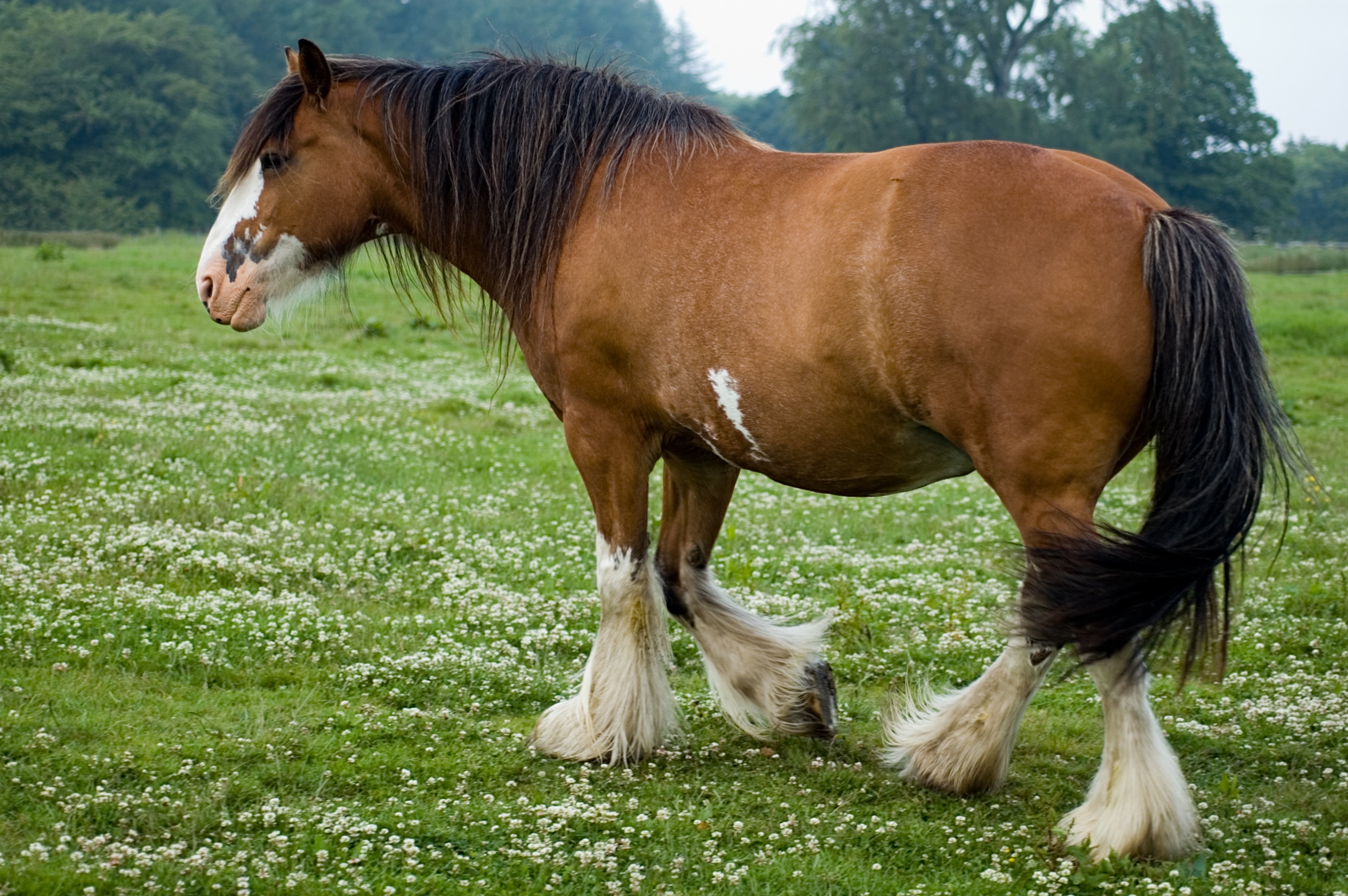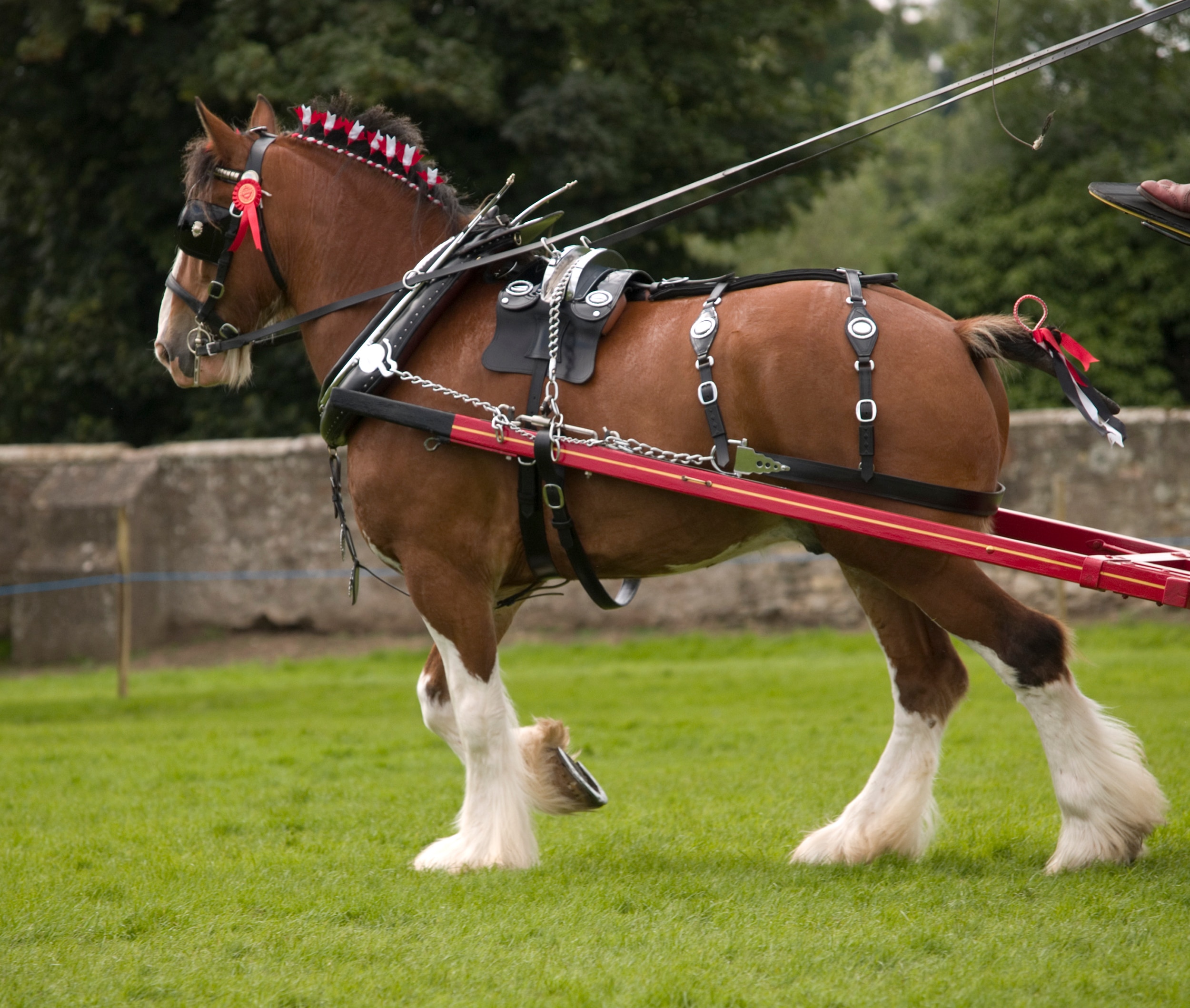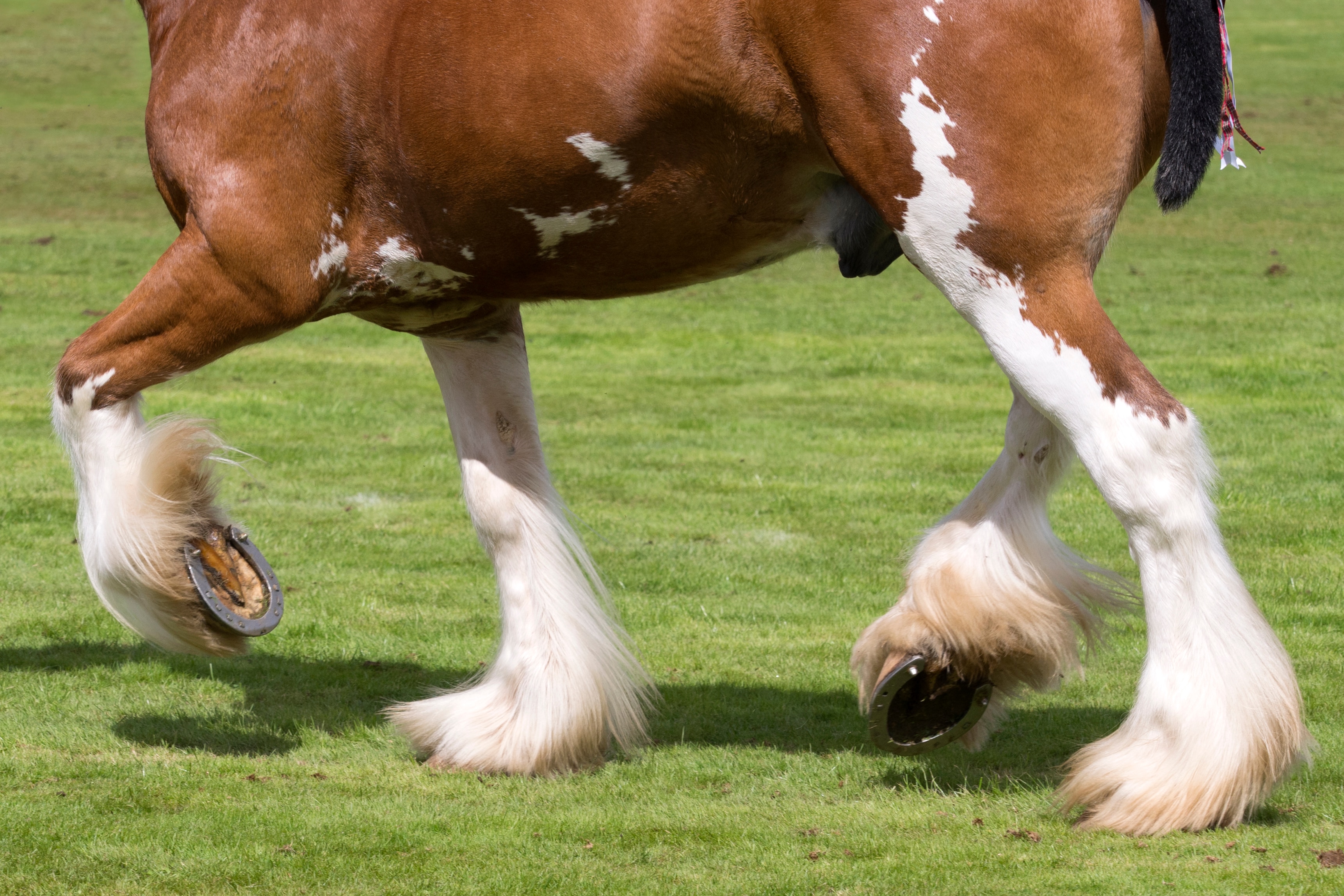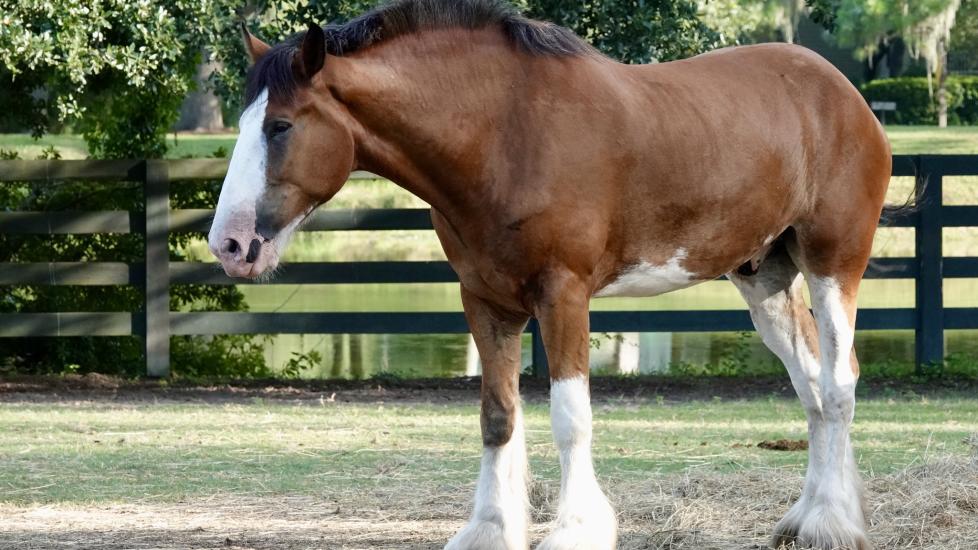Clydesdale Horse
Chris Klonowski/iStock / Getty Images Plus via Getty Images
Clydesdale horses are the most widely known draft horse breed in the United States because they are the official Budweiser® hitch-horses. The famous Budweiser Clydesdales are easily identifiable by their bay coat color (though there are many other Clydesdale colors), black manes and tails, white blazes, white lower legs, and flowing leg hair known as feathers.
Before beautiful Clydesdales became famous in Super Bowl commercials, this draft breed was first bred for farm and industrial work along the banks of the River Clyde in Lanarkshire, Scotland.
Clydesdale Snapshot
The Clydesdale horse breed was originally developed in Scotland for agriculture work and coal hauling. Today, they are mostly used to pull carriages and compete in shows. They are also ridden and kept for pleasure. A small number of Clydesdales are still used for farm work and logging.
Like any horse breed, the size and coat colors of Clydesdales varies. The characteristics listed below are averages.
-
Height: 16.2–19 hands (5.4 to 6.3 feet) to the highest point of the withers
-
Weight: 1,500–2,200+ pounds
-
Lifespan: 20 to 25 years
-
Colors: Bay is the most common Clydesdale color, though there are also chestnut, roan, and black Clydesdales. Many have prominent white markings on the legs and face.
Caring for a Clydesdale
Clydesdale Farm/Housing
The amount of space needed to safely house this breed depends on your Clydesdale horse’s size. A 16.2-hand Clydesdale won’t need the space a 19.2-hand Clydesdale will. Typically, a 12-by-12-foot stall is sufficient for the horse to lie down but not too big where he will try to roll and possibly get cast (down on their side, with their limbs positioned against the wall in such a way that they cannot rise).
“You can walk into 10 barns and see 10 different-sized stalls,” says Shelby Zarobinski, a Clydesdale horse breeder and owner of Sandy Acres Clydesdales in La Porte, Indiana. She is also second vice president of the Clydesdale Breeders of the U.S.A. (CBUSA) and spent five years working for the Budweiser Clydesdale West Coast team.
A Clydesdale farm that breeds horses “will commonly see foaling stalls that are 12 feet by 24 feet, to allow the mare and foal space to move around,” she says.
Clydesdale Turnout
In a perfect world, any horse breed would have acres of pastures. However, the reality is that most horse owners do not have hundreds of acres of land. Providing a space large enough to offer your Clydesdale room to stretch their legs is essential—and like stalls, dimensions vary.
“Our show horses get a 50-foot-by-150-foot turnout each so they can be outside next to horses but not be with horses to reduce the possibility of getting hurt,” Zarobinski says.

Clydesdale Manure
Manure is another important factor to consider when owning a Clydesdale. “Assuming your horse is turned out year-round with adequate shelter to get out of the elements, a 2,000-pound horse will produce about 62 pounds of feces daily,” she says. “This equals about 22,200 pounds of feces in a year, so just a little over 11 tons!”
Stalling a horse increases manure output. Combined with used bedding, feces, and urine, this number can jump to about 100 pounds a day in total waste material, or 18.25 tons a year ,she notes.
“A lot of factors go into this, such as how often you clean your pastures or lots, and whether your horse is partially stalled or full-time stalled,” she says.
Clydesdale Health Issues
Clydesdales are generally healthy horses, but like many other breeds they are predisposed to a few health issues. Always consult your veterinarian if you notice changes in your horse’s health or if you’re concerned about these conditions.
These are a few common health conditions in Clydesdale horses you should know about:
Chronic Progressive Lymphedema (CPL)
Chronic progressive lymphedema is due to a poorly functioning lymphatic system, which is responsible for maintaining appropriate fluid levels throughout the body, housing white blood cells, and filtering out waste and bacteria.
When this system doesn’t work properly, fluid accumulates in the lower limbs, which can lead to the following symptoms:
-
Skin thickening
-
Mass-like nodules
-
Significant swelling of the leg
-
Open sores
-
Severe infection
While there is no definitive treatment for this disease, CPL can be managed by keeping the feathers clipped and lower legs clean, treating any open wounds promptly, and compression bandages may be helpful if applied appropriately. Daily exercise is critical in helping the lymphatic system move fluid up and out of the limbs; prolonged stall rest is therefore not ideal.
Shivers
Shivers is a neuromuscular condition that affects the horse’s hind legs and tail. Signs include trembling legs, hyperflexion (extension of the hind limbs), or shaking around a raised tail, most commonly observed when the horse is backing up.
This condition can make it difficult to pick up a horse’s hind feet for cleaning, trimming, or shoeing. A Clydesdale with shivers may have difficulty backing or may get a leg stuck in midair. Over time there may be muscle atrophy in the hind limbs and weakness. Spasming of muscles in the neck and face may also be observed, but front limbs are usually not involved.
There is no cure for shivers in horses; however, a veterinarian is likely to recommend changes in diet and exercise and may suggest vitamin E and selenium supplementation.
Scratches
Clydesdales are known for their distinctive leg hairs, called feathers. The extra hair can make them more prone to scratches, a condition where bacteria invade small cracks in the skin around the heels and back of the pastern.
Symptoms of scratches in horses include lesions, oozing, swelling, and sensitivity in the area.
Treatment typically includes clipping the hair, followed by cleaning the affected area with a mild cleanser and topical antibiotics, antifungals, or steroids (Animax®, dexamethasone). Systemic antibiotics such as oral trimethoprim sulfa or an Excede® injection may be used. Regularly rinsing the dirt from the horse’s feathers and keeping horses out of consistently wet, muddy, or mucky conditions can help prevent scratches.
Canker
Clydesdales, the gentle giants, are famous for their large dinner plate-sized feet, which may be more susceptible to bacterial infection. While it may look similar to thrush in early stages, canker causes abnormal tissue growth, rather than tissue death/necrosis like thrush. Common symptoms of canker may include:
-
White cauliflower-looking growth, which typically starts in the frog but can spread across the entire sole and spread further into the foot
-
Foul smell
-
White, greasy, discharge that looks similar to cottage cheese
-
Lameness if infection is severe
Canker is typically treated with thorough and specific debridement (cutting away) down to healthy tissue; this may often be a bloody procedure, especially if the infection is deep. Topical medications may vary depending on case, but they often include metronidazole, a benzoyl peroxide/acetone mix, lidocaine, or other therapy using bandages or hospital shoes.
It is critical to keep the foot clean and dry during the healing process, as the bacteria favors moist environments and reoccurrence may occur during the healing period. Oral antibiotics may also be used in severe cases.
What To Feed a Clydesdale
Clydesdale horses eat what most horses eat—hay, grass, and grain, depending on the individual horse. Work with your veterinarian and an equine nutritionist to determine what type of ration to give your Clydesdale, especially if they have an underlying condition such as respiratory or metabolic concerns.
“A mature Clydesdale can eat 50 to 60 pounds of hay, 2 to 15 pounds of feed, and consume 30 gallons of water in a single day,” Zarobinski says. “Just like humans, their diets change.”
Like humans, the amount of food needed changes based on your Clydesdale’s weight, age, exercise level, and underlying health conditions.
Clydesdale Disciplines
Before fuel powered tractors and trucks, Clydesdales provided the horsepower to travel and move heavy loads, and they are quite versatile.
The CBUSA encourages members to use their Clydesdale horses in many different disciplines, from ground work to carriage driving to riding. Some Clydesdale owners participate in the United States Dressage Federation All-Breeds Dressage Awards. Others ride their horses in an English or western saddle in competitions and on the trail.

Clydesdale Personality and Temperament
Clydesdale horses are often compared to Labrador Retrievers, which are known for being gentle and steadfast. The Clydesdale’s laid-back demeanor often makes them suitable for novices.
Draft horse breeds like the Clydesdale are frequently called “gentle giants” because, despite their size, they are relatively calm and easygoing.
“Clydesdales are generally very gentle and laid back,” says Zarobinski. “They are easy to get along with and adapt to various situations well.”
Clydesdale Training
“Many Clydesdale breeders start handling and introducing the foals to various things from the day they are born,” says Zarobinski. As a Clydesdale foal matures, it’s important to continue introducing them to new situations.
Around age 2, many Clydesdale breeders and trainers introduce the biting rig, which prepares a young horse to transition into the full harness or a surcingle to simulate the tightness of a girth/cinch for riding, which starts around age 3.
“Just like any horse, you have to find out what works for that individual and tailor your methods around that,” Zarobinski adds. “A general rule of thumb is to start young and never stop training. The best thing you can do is raise an animal with manners, [and one that] ties, and loads.”

Clydesdale Grooming Guide
Coat Care
Begin a typical grooming routine with a circular rubber curry comb to loosen dirt and loose hair. You can even use a horse vacuum to remove it. Next, comb the mane, tail, and forelock, and use a medium bristle brush to go over the whole body, switching to a soft bristle brush on the face and legs.
Before finishing, you can mist the entire body with a coat conditioner and fly spray in the summer. Condition a Clydesdale’s feathers with mineral oil and sulfur a few times a week to help keep the feathers soft; sulfur has antimicrobial and antifungal properties.
“This helps prevent any scratches that Clydesdales are prone to and helps the feather resist staining from urine, manure, or grass,” Zarobinski says.
Daily grooming is an important part of caring for a horse’s coat, but nutrition and a good feeding program are the most important aspects of maintaining a healthy coat.
Hoof Care
Clydesdales are known for having large hooves. Their feet are about as large as a dinner plate, measuring about 10 inches across. Like every other horse breed, it’s important to schedule routine farrier visits.
Every horse is an individual. A farrier will recommend how often your Clydesdale needs to have their hooves trimmed and whether they need horseshoes, based on the horse’s hoof quality and activity.

Clydesdale Horse FAQs
How tall is a Clydesdale?
A typical Clydesdale horse will stand at 16.2–19.2 hands at the withers.
How much does a Clydesdale weigh?
Clydesdale horses can weigh from 1,500 to over 2,200 pounds.
How much does a Clydesdale horse cost?
Clydesdale horse prices depend on the lineage and intended use of a Clydesdale. Purchase price may range from a few thousand to tens of thousands of dollars. It is important to remember that this is just the initial investment in horse ownership, and yearly care costs add up quickly.
How much does a Clydesdale cost to feed?
The cost of feeding a horse can vary widely, depending on age, work load, and metabolic status. Adults can eat on average 50 pounds of hay and up to 15 or more pounds of grain every day, which can get quite expensive depending on the grain being fed. Hay costs can vary widely based on geographical area, season, and type of grass being used. Pasture grazing is less expensive than feeding bales of hay, but it may not be feasible for every horse owner.
